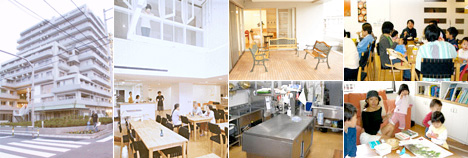“Forest” Cohousing in Japan, Pt.I
by Diana Leafe Christian (for Cohousing Journal online, February, 2008)
As cohousing is increasingly becoming a global phenomenon, I’ve become curious to learn how different countries mold the concept to reflect their cultural, financial, and regulatory realities. I learned that firsthand after I had a chance to see three cohousing projects in Japan recently.
After the Japanese Ecovillage Conference in Tokyo in late November, 2007, three of us visited the 28-unit Kankanmori no Kaze Cohousing project in Tokyo. My two friends were Giovanni Ciarlo from Huehuecoyotl Ecovillage in Mexico, and Akemi Miyauchi, one of our wonderful conference hosts. Giovanni and I had given presentations about intentional communities at the conference, and we were eager to see similar projects in Japan. There appear to be relatively few intentional communities in that island nation, and perhaps only four cohousing communities so far—depending on how one defines the term.
We first learned of Kankanmori at the conference through presentations on what the Japanese call “collective housing” in Sweden, Denmark, the US, and Japan. I was quite surprised to learn that the first example one conference presenter could find of collective housing in modern times was in Sweden before World War II, where single mothers organized shared apartment buildings with common kitchen/dining rooms and shared childcare.

Kankanmori no Kaze (which means “The Winds of Kankanmori Forest”) is located in the 12-story Nippori Community House in the Arakawa section of Tokyo. The second and third floors contain the apartment units, common spaces, and rooftop terraces of the multi-generational Kankanmori Cohousing. However, the other floors are not part of the cohousing project: the ground floor is a restaurant, a nursery school, and a medical services station staffed by nurses for residents and neighbors, the higher floors contain a nursing home and independent-living apartments for mobile seniors, and the top floor offers furo bath facilities all residents can use.
Kankanmori differs from most cohousing projects in the West in that it is entirely rental units. The studio and two-bedroom units (no one-bedroom units), which range from 270 to 645 sq. feet, rent for between approximately $640 to $1550 a month, plus about $65 a month for each unit’s share of utilities for the common spaces. The Kankanmori project was considered quite an experiment, as its future residents gave their input into the design, and provide the cleaning and maintenance of the common spaces—unusual for Japan.
Giovanni, Akemi, and I entered Kankanmori through an outdoor stairway to the second floor entrance, where we met architect and project founder Hiroko Kimura, who gave us a tour of the common facilities. On the first cohousing floor we saw the common kitchen and pantry, which looked like every common house kitchen I’ve ever seen but for the row of rice cookers, a bamboo vegetable steamer, and Japanese rather than English on the labels of every package, bottle, and can. We toured the spacious dining room, the small living room off the dining room, and the outdoor dining terrace with a living “wall” of trellised vines on the balcony. We visited the children’s play area, bathroom, laundry and ironing rooms, the indoor/outdoor woodworking/crafts terrace, and the flower garden and vegetable garden terraces. Located on the roof of the first floor, the gardens had deep raised garden beds in wooden frames, wooden walkways, and rows of plastic compost bins. On the next floor of the cohousing complex we saw the group’s office, library shelves, woodworking shop, and guest room.
Located on the roof, the flower garden and vegetable garden terraces had deep raised beds in wooden frames, wooden walkways and rows of plastic compost bins. The Japanese had an ancient, even sacred, sense of connection to nature, especially trees and forests. (They’ve preserved 66% of their island nation in forest, which is impressive, given the pressure to cut forests to get more arable land to feed a population of 127 million.) But nowadays most Japanese in urban areas live in small box-like apartments in concrete high-rises, with little connection to neighbors or nature. Land is so expensive that few housing developers include gardens or landscaping. So Kankanmori’s connection to neighbors and to nature once again is quite exceptional.
Ms. Kimura also showed us the community’s bulletin-board systems for cooking and cleaning schedules and using the laundry facilities, and described how they worked. People write their names on small brightly colored circular magnets, which they place on a large wall calendar on the dates on which they’d like to cook and clean. In the laundry room they affix small paper tags to their washer or dryer they’re using to let the next person know how to dry their wet loads or where to put their dried loads before they put in their own. Ms. Kimura also described community meetings, and told us that when residents have differences, “We just talk together until we can come to agreement about what to do.”
The most moving part of the tour, for me, was that while I was 5,000 miles from North America, visiting a culture significantly different from my own, the common spaces and description of Kankanmori’s cooking rotation, laundry use, and interpersonal process were so familiar. Giovanni and I told Ms. Kimura that the kinds of conflicts and topics she described in their meetings also came up at Huehuecoyotl and Earthaven as well. Whether in Mexico, Japan, or North Carolina, communitarians seem to evoke the same set of living-together issues!
Before we left Kankanmori, Ms. Kimura invited us to participate in one of their common meals the next time we came to Tokyo. We said we’d love to!
Part II will examine two additional high-density housing projects in Tokyo that combine individual units with unusual methods for creating common space.
![]()
Diana Leafe Christian is editor of a free online ecovillage newsletter, “Ecovillages and Sustainable Communities.” (Diana@ic.org).
Author of Finding Community: How to Join an Ecovillage or Intentional Community, and Creating a Life Together: Practical Tools to Grow Ecovillages and Intentional Communities, she was editor of Communities magazine for 14 years.
Diana lives at Earthaven Ecovillage in North Carolina.






